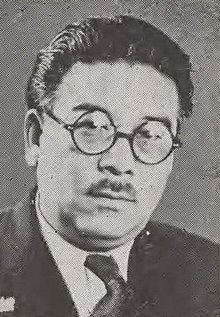| Hisashi Asō | |
|---|---|
| 麻生 久 | |
 Hisashi Asō in 1937 Hisashi Asō in 1937 | |
| Born | (1891-05-24)May 24, 1891 Oita Prefecture, Japan |
| Died | September 6, 1940(1940-09-06) (aged 49) Tokyo, Japan |
| Nationality | Japanese |
Hisashi Asō (麻生 久, Asō Hisashi, May 24, 1891 – September 6, 1940) was a Japanese socialist, politician, and trade unionist.
Biography
Hisashi Asō was born in the Oita Prefecture in 1891. He enrolled in the French Law Department of Tokyo Imperial University in 1913 and graduated in 1917. Following this, he worked as a journalist at the Tokyo Nichinichi Shimbun but left before long to aid in founding the Renmeikai and Shinjinkai in December 1918 with Yoshino Sakuzō.
During the 1920s, Asō became active in the Japanese labor movement. He participated in several labor disputes and, joining the Yūaikai in 1919, became the union's political section chief in 1925. In 1926, however, the leadership of the union expelled Asō and several others over secret plans to create a centrist proletarian party. He then created the Japan Labour Union League and Japan Labour-Farmer Party with the expelled members in December 1926, becoming the party's Chairman. In July 1932, he participated in the founding of the Socialist Masses Party and became Secretary-General of the party. Finally, in 1936, Asō won a seat in the House of Representatives for District 5 of Tokyo.
Asō also began to move towards collaboration with renovationist elements of the right-wing in the 1930s. Although condemning the Manchurian Incident as capitalistic and imperialist, he claimed that it had pushed the army in an anti-capitalist direction and became involved in the March Incident of 1931. After the release of an army pamphlet espousing anti-capitalist principles in 1934, Asō also become one of the strongest advocates of collaboration with the army along with his fellow party member Kanichirō Kamei. He similarly embraced the Konoe New Order as a method to achieve socialism. In 1938, Asō, Kamei, and Akiyama Teisuke worked together to draft plans for a new reformist, totalitarian political party to be led by themselves and Fumimaro Konoe. The following year, Asō and Kamei managed to push for a merger of the Socialist Masses Party and Tōhōkai against the reservations of party President Abe Isoo, only for the merger to fail at the last minute.
In 1940, Asō succeed Abe as President of the Socialist Masses Party after the latter left with other members of the party's right-wing faction due to opposing Saitō Takao's expulsion. He would lead the party to dissolution on 6 July 1940 in anticipation of obtaining a leading role in Konoe's Imperial Rule Assistance Association, but died of a heart attack only two months later in September.
References
Citations
- ^ Kotobank.
- Large 1981, p. 23.
- Gordon 1991, p. 183.
- Gordon 1991, p. 305.
- Kersten 2006.
- Gordon 1991, p. 283.
- Itō 2015, p. 69-70.
- Berger 1977, p. 167.
- Berger 1977, p. 277.
Sources cited
- Kotobank. "麻生久". Kotobank (in Japanese). Retrieved 16 May 2024.
- Berger, Gordon (1977). Parties Out of Power in Japan, 1931-1941. Princeton, NJ: Princeton University Press. ISBN 9780691031064.
- Gordon, Andrew (1991). Labor and Imperial Democracy in Prewar Japan. Berkeley and Los Angeles, CA: University of California Press. ISBN 9780520080911.
- Itō, Takashi (2015). Taisei Yokusankai e no Michi - Konoe Shintaisei (in Japanese). Japan: Kodansha Gakujutsu Bunko. ISBN 978-4-06-292340-8.
- Kersten, Rikki (2006). "Painting the Emperor Red: The Emperor and the Socialists in the 1930s". In Kersten, Rikki; Williams, David (eds.). The Left in the Shaping of Japanese Democracy: Essays in Honour of J.A.A. Stockwin. Routledge. ISBN 978-0415334341.
- Large, Stephen S. (1981). Organized Workers and Socialist Politics in Interwar Japan. Cambridge, NY: Cambridge University Press. ISBN 9780521236751.